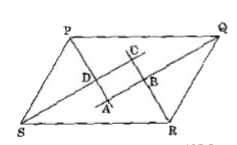In △PQR,∠P:∠Q:∠R=1:2:3. Prove that p:q:r=1:√3:2
Video Solution
Text Solution
Let the common ratio bex.
∴ Angles are x,2x and 3x
Now, x+2x+3x=180∘ [Angle sum property of a triangle]
6x=180∘
x=30∘
∴ Angles are 30∘,60∘ and 90∘
Now, by sine rule,
psinP=qsinQ=rsinR
⇒psin30∘=qsin60∘=rsin90∘
p12=q√32=r1=k (say)
p:q:r=k2:√3k2:k
∴ The required ratio is 1:√3:2
Hence proved.
|
Updated on:21/07/2023
Topper's Solved these Questions
- BOOK - AAKASH INSTITUTECHAPTER - TRIGNOMETRIC FUNCTIONS EXERCISE - Try Yourself32videos
TRIGNOMETRIC FUNCTIONS
- BOOK - AAKASH INSTITUTECHAPTER - TRIGNOMETRIC FUNCTIONS EXERCISE - Assignment section-A (Objective Type Questions (One option is correct))49videos
TRIGNOMETRIC FUNCTIONS
- BOOK - AAKASH INSTITUTECHAPTER - THREE DIMENSIONAL GEOMETRY EXERCISE - ASSIGNMENT SECTION - J10videos
THREE DIMENSIONAL GEOMETRY
- BOOK - AAKASH INSTITUTECHAPTER - VECTOR ALGEBRAEXERCISE - SECTION-J (Aakash Challengers Questions)5videos
VECTOR ALGEBRA
Similar Questions
Knowledge Check
- Question 1 - Select One
In △PQR,∠P=∠Q=∠R. If PQ = 6, then the perimeter of △PQR is ..........
A12B9C18D24 - Question 2 - Select One
The following steps are involved in finding the largest angle of a quadrilateral PQRS, if ∠P:∠Q:∠R:∠S=1:2:3:4. Arrange them in sequential order.
(A) 10x=360∘⇒x=36∘
(B) Let the angles be ∠P=x,∠Q=2x,∠R=3x,and∠S=4x.
(C ) The largest angle =4(36∘)=144∘
(D) Given ∠P:Q:∠R:S=1:2:3:4
(E ) ∠P+∠Q+∠R+∠S=360∘⇒x+2x+3x+4x=360∘ADBAECBDBACECDBECADDBEAC - Question 3 - Select One
In a triangle PQR, ∠R is greater than ∠Q by 9∘. If ∠P=α∘,∠Q=(3α−2)∘, and ∠R=β∘ then find all the angles of the triangle.
A30∘,60∘,90∘B45∘,45∘,90∘C25∘,73∘,82∘Dnone of these

In the figure given above, PQRS is parallelogram. If AP, AQ, OR, CS are bisectors of ∠P,∠Q,∠R and ∠S respectively, then ABCD is aView SolutionConstruct a triangle PQR, such that ∠P=50∘,∠Q=30∘ and PQ−QR=1.4cm.
View SolutionABCD is a cyclic quadrilateral whose diagonals intersect at a point E. If ∠DBC=70∘ , ∠BAC is 30∘ , find ∠ BCD. Further if AB=BC, find ∠ ECD.
View SolutionIn a parallelogram ABCD, the sum of any two consecutive angles is 180∘ and opposite angles are equal.
Find the value of ∠Qand∠P , if ∠P=10aand∠R=50∘ in a parallelogram PQRS.View SolutionIn △PQR,∠R=π2. If tan(P2) and tan(Q2)are roots of equation, ax2+bx+c=0, then which of the following is true.
View Solution

